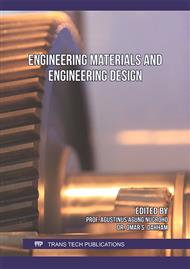[1]
R.H. Sanders, B.D. Wilson, Factors contributing to maximum height of dives after takeoff from the 3m springboard, J Appl Biomech. 4 (1988) 231–259.
DOI: 10.1123/ijsb.4.3.231
Google Scholar
[2]
D.I. Miller, C.F. Munro, Body segment contributions to height achieved during the flight a springboard dive, Med Sci Sports Exerc. 16 (1984) 234–242.
DOI: 10.1249/00005768-198406000-00007
Google Scholar
[3]
I.C. Jones, D.L. Miller, Influence of fulcrum position on springboard response and takeoff performance in the running approach, J Appl Biomech. 12 (1996) 383–408.
DOI: 10.1123/jab.12.3.383
Google Scholar
[4]
K.B. Cheng, M. Hubbard, Optimal compliant-surface jumping: a multi-segment model of springboard standing jumps, J Biomech. 38 (2005) 1822–1829.
DOI: 10.1016/j.jbiomech.2004.08.023
Google Scholar
[5]
M.A. King, P.W. Kong, M.R. Yeadon, Determining effective subject-specific strength levels for forward dives using computer simulations of recorded performances, J Biomech. 42 (2009) 2672–2677.
DOI: 10.1016/j.jbiomech.2009.08.007
Google Scholar
[6]
D. Miller, M.J. Osborne, I.C. Jones, Springboard oscillation during hurdle flight, J Sports Sci. 16 (1998) 571–583.
DOI: 10.1080/026404198366533
Google Scholar
[7]
D.I. Miller, A. Zecevic, G.W. Taylor, Hurdle preflight in springboard diving: a case of diminishing returns, Res Q Exerc Sport. 73 (2002) 134–145.
DOI: 10.1080/02701367.2002.10609002
Google Scholar
[8]
D.I. Miller, Springboard and platform diving, in: V. Zatsiorsky (ed), Biomechanics in sport, Oxford: Blackwell Science, 2000, 326–348.
DOI: 10.1002/9780470693797.ch16
Google Scholar
[9]
FEDEC - Fédération Européenne Des Écoles de Cirque professionnelles, Basic circus arts instruction manual: supplements: chapter 9 teeterboard, (2009). http://www.fedec.eu/file/242/ download
Google Scholar
[10]
M. Cossin, A. Ross, F. Prince, Effect of Jump heights, Landing Techniques and Participants on Vertical Ground Reaction Force and Loading Rate During Landing on Three Different Korean Teeterboards, Proc. Inst. Mech. Eng. (2021).
DOI: 10.1177/17543371211058031
Google Scholar
[11]
D. Pearsall, S. Robbins, Design and materials in ice hockey. In: Materials in sports equipment, Woodhead Publishing, (2019) 297–322.
DOI: 10.1016/b978-0-08-102582-6.00010-1
Google Scholar
[12]
A. Villaseñor, R.A. Turcotte, D.J. Pearsall, Recoil effect of the ice hockey stick during a slap shot, J Appl Biomech. 22 (2006) 202–211.
DOI: 10.1123/jab.22.3.202
Google Scholar
[13]
D.J. Pearsall, D.L. Montgomery, N. Rothsching, R.A. Turcotte, The influence of stick stiffness on the performance of ice hockey slap shots, Sports Eng. 2 (1999) 3–12.
DOI: 10.1046/j.1460-2687.1999.00018.x
Google Scholar
[14]
T.C. Wu, D. Pearsall, A. Hodges, R. Turcotte, R. Lefebvre, D. Montgomery, H. Bateni, The performance of the ice hockey slap and wrist shots: the effects of stick construction and player skill, Sports Eng. 6 (2003) 31–39.
DOI: 10.1007/bf02844158
Google Scholar
[15]
J.T. Worobets, J.C. Fairbairn, D.J. Stefanyshyn, The influence of shaft stiffness on potential energy and puck speed during wrist and slap shots in ice hockey, Sports Eng. 9 (2006) 191–200.
DOI: 10.1007/bf02866057
Google Scholar
[16]
A. Villaseñor-Herrera, Recoil effect of the ice hockey stick during a slap shot, M.Sc. Thesis, Canada: McGill University (2004).
Google Scholar
[17]
T. Woo, J. Loh, R. Turcotte, D. Pearsall, The ice hockey slap shot, elite versus recreational, in ISBS-Conference Proceedings Archive (2004).
Google Scholar
[18]
M. Cossin, A. Ross, F. Prince, A Kinematic Analysis of Jumping Technique in Elite Korean Teeterboard Athletes: A Case-study, Sports Biom. (2021).
DOI: 10.1080/14763141.2021.2018030
Google Scholar
[19]
D.I. Miller, I.C. Jones, Characteristics of Maxiflex® Model B springboards revisited, Res Q Exerc Sport. 70 (1999) 395–400.
DOI: 10.1080/02701367.1999.10608060
Google Scholar
[20]
R.W. Clough, J. Penzien, Dynamics of Structures McGraw-Hill, Inc Editor, 1993.
Google Scholar
[21]
A. Mikael, Evaluation des paramètres physiques des bâtiments: amortissement, fréquence et modes de comportement des structures de génie civil: Approche expérimentale. PhD Dissertation, France: Grenoble (2011).
Google Scholar
[22]
J. Elith, J.R. Leathwick, T. Hastie, A working guide to boosted regression trees, J Anim Ecol. 77 (2008) 802–813.
DOI: 10.1111/j.1365-2656.2008.01390.x
Google Scholar
[23]
Team RC, R: A language and environment for statistical computing, 2013.
Google Scholar
[24]
W.L. Boda, Modelling the springboard and diver as an oscillating spring system. PhD Dissertation, University of Massachusetts Amherst (1992).
Google Scholar
[25]
B.W. Kooi, M. Kuipers, The dynamics of springboards, J Appl Biomech. 10 (1994) 335–351.
Google Scholar
[26]
M. Sayyah, M.A. King, M.J. Hiley, M.R. Yeadon, Functional variability in the takeoff phase of one metre springboard forward dives, Hum Mov Sci. 72 (2020) 102634.
DOI: 10.1016/j.humov.2020.102634
Google Scholar
[27]
J. Sell, F. Kropf, Propriétés et caractéristiques des essences de bois, Lignum, 1990.
Google Scholar


